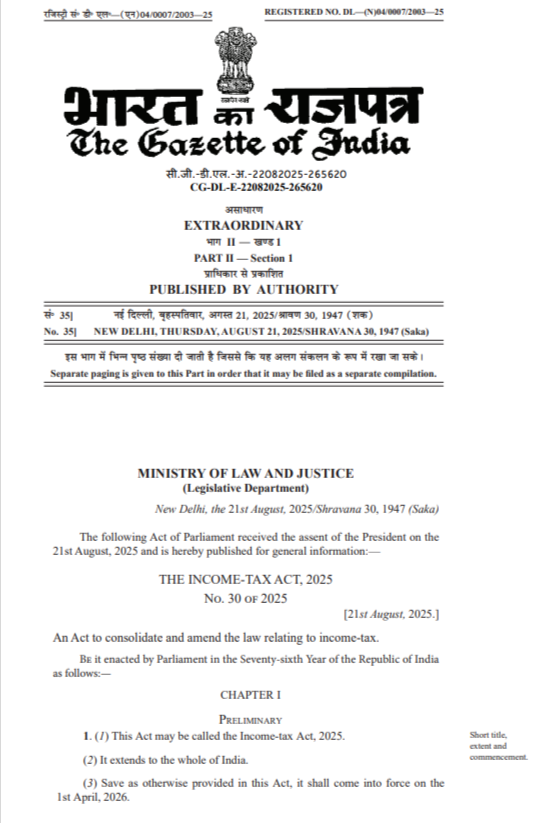| PDF Title | Income-Tax Act, 2025 (Bill No. 30 of 2025) – Key Highlights |
| Category | |
| Order no | Bill No. 30 |
| Order Date | Aug 21, 2025 |
| Total Pages | 572 |
| Posted By | Admin |
| Posted On | Aug 25, 2025 |

Get PDF in One step
| PDF Title | Income-Tax Act, 2025 (Bill No. 30 of 2025) – Key Highlights |
| Category | |
| Order no | Bill No. 30 |
| Order Date | Aug 21, 2025 |
| Total Pages | 572 |
| Posted By | Admin |
| Posted On | Aug 25, 2025 |

MINISTRY OF LAW AND JUSTICE
(Legislative Department)
New Delhi, the 21st August, 2025/Shravana 30, 1947 (Saka)
The following Act of Parliament received the assent of the President on the 21st August, 2025 and is hereby published for general information:—
THE INCOME-TAX ACT, 2025
No. 30 of 2025
[21st August, 2025.]
An Act to consolidate and amend the law relating to income-tax.
Be it enacted by Parliament in the Seventy-sixth Year of the Republic of India as follows:—
CHAPTER I
PRELIMINARY
Short title, extent and commencement.
1. (1) This Act may be called the Income-tax Act, 2025.
(2) It extends to the whole of India.
(3) Save as otherwise provided in this Act, it shall come into force on the 1st April, 2026.
Definitions.
2. In this Act, unless the context otherwise requires,—
(1) “accountant” shall have the meaning assigned to it in section 515(3)(b);
(2) “Additional Commissioner” means a person appointed to be an Additional Commissioner of Income-tax under section 237(1);
(3) “Additional Director” means a person appointed to be an Additional Director of Income-tax under section 237(1);
(4) “advance tax” means the advance tax payable as per Chapter XIX-C;
(5) “agricultural income” means—
(a) any rent or revenue derived from a land which is situated in India and is used for agricultural purposes;
(b) any income derived from such land by—
(i) agriculture; or
(ii) the performance by a cultivator or receiver of rent-in-kind of any process ordinarily employed by a cultivator or receiver of rent-in-kind to render the produce raised or received by him fit to be taken to market; or
(iii) the sale by a cultivator or receiver of rent-in-kind of the produce raised or received by him, in respect of which no process has been performed other than a process of the nature described in item (ii);
(c) any income derived from any building owned and occupied by the receiver of the rent or revenue of any such land, or occupied by the cultivator or the receiver of rent-in-kind, of any such land with respect to which, or the produce of which, any process mentioned in sub-clause (b)(ii) and (iii) is carried on, where such building––
(i) is on or in the immediate vicinity of such land and that land is assessed to land revenue in India, or is subject to a local rate assessed and collected by officers of the Government as such, or where the land is not so assessed to land revenue or subject to a local rate it is not situated in any area as specified in clause (22)(iii)(A) or (B); and
(ii) is required as a dwelling house, or as a store-house, or other out-building, by the receiver of the rent or revenue or the cultivator, or the receiver of rent-in-kind, by reason of his connection with the land;
(d) any income derived from saplings or seedlings grown in a nursery, but shall not include––
(i) the income derived from any building or land referred to in sub-clause (c) arising from the use of such building or land for any purpose (including letting for residential purpose or for the purpose of any business or profession) other than agriculture falling under sub-clause (a) or (b); or
(ii) any income arising from the transfer of any land referred to in clause (22)(iii)(A) or (B);
(6) “amalgamation”, in relation to companies, means the merger of one or more companies with another company or the merger of two or more companies to form one company (the company or companies which so merge being referred to as the amalgamating company or companies and the company with which they merge or which is formed as a result of such merger being referred to as the amalgamated company) in such a manner that—
(a) all the property of the amalgamating company or companies immediately before the amalgamation become the property of the amalgamated company by virtue of the amalgamation;
(b) all the liabilities of the amalgamating company or companies immediately before the amalgamation become the liabilities of the amalgamated company by virtue of the amalgamation;
(c) the shareholders holding not less than three-fourths in value of the shares in the amalgamating company or companies (other than shares already held therein immediately before the amalgamation by, or by a nominee for, the amalgamated company or its subsidiary) become shareholders of the amalgamated company by virtue of the amalgamation,
otherwise than as a result of the acquisition of the property of one company by another company pursuant to the purchase of such property by the other company or as a result of the distribution of such property to the other company after the winding up of the first-mentioned company;
(7) “annual value”, in relation to any property, means its annual value as determined under section 21;
(8) “Appellate Tribunal” means the Appellate Tribunal constituted under section 361;
(9) “approved gratuity fund” means a gratuity fund, which is approved and continues to be approved by the approving authority as per Part B of Schedule XI;
Continue reading and download the PDF from the link below: